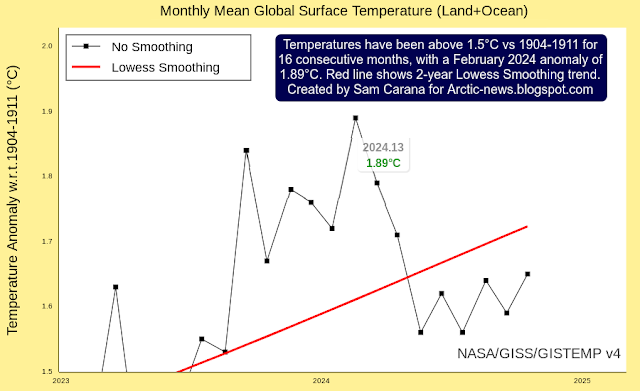 |
| [ click on images to enlarge ] |
The above image shows Arctic sea ice extent from November 5 to December 24, a period when Arctic sea ice is growing in extent. The red line shows 2024 sea ice extent through November 23, 2024. Dots mark Arctic sea ice extent on November 23 for the respective year. On November 23, Arctic sea ice extent was lower only in 2016, which is worrying, since El Niño conditions were dominant in 2016, whereas La Niña conditions are now dominant.

The image below shows NOAA monthly temperature anomalies versus El Niño through October 2024.

The image below shows Antarctic sea ice extent during the months September and October, highlighting extent in 2023 and 2024, as compared to extent averages in previous decades.

As illustrated by the above image, Antarctic sea ice extent in September and October 2023 & 2024 was much lower than in previous decades, a huge difference that occurred during a period when little or no sunlight was reaching Antarctic sea ice. On November 9, 2024, Antarctic sea ice extent was 14.99 million km², a record low for the time of year.
Global sea ice typically reaches its annual maximum extent around this time of year, as Arctic sea ice expands in extent. On November 9, 2024, global sea ice extent was 23.34 million km², a record low for the time of year and well below the 24.15 million km² on November 9, 2023.

Higher ocean heat in combination with higher air temperatures over the Arctic Ocean are two drivers behind the current slow growth in Arctic sea ice extent, which is in turn keeping global sea ice extent low.
Record low Arctic sea ice extent of 3.387 million km² was reached on September 17, 2012 (image below left).
At the same time, rising ocean heat has caused a steady decrease in the volume of Arctic sea ice, as illustrated by the image on the right.
 |
| [ click on images to enlarge ] |
Since the minimum extent of Antarctic sea ice is much lower than the minimum sea ice extent in the Arctic, it may well be that a Blue Ocean Event (BOE) will occur in the Southern Hemisphere, before occurring in the Northern Hemisphere.
A double Blue Ocean Event could occur in 2025. Both Antarctic sea ice and Arctic sea ice could virtually disappear in 2025. A BOE occurs when sea ice extent falls to 1 million km² or less, which could occur early 2025 for Antarctic sea ice and in Summer 2025 in the Northern Hemisphere for Arctic sea ice.


An Antarctic Blue Ocean Event in early 2025 would have terrifying consequences; it would rapidly and dramatically drive up global temperatures and threaten to unleash a double Blue Ocean Event in 2025.
On November 30, 2024, the sea surface temperature of the US Atlantic was as high as 31.1°C.
On November 28, 2024, the sea surface temperature was 27.1°C in the Gulf of Mexico, 2.07°C higher than 1982-2010.
 |
| [ click on images to enlarge ] |
Historic rise: more than 1.5°C above 1903-1924 for 16 consecutive months

How appropriate is the use of a 1903-1924 base? Using a different base can make a lot of difference. As illustrated by the image below, the temperature anomaly for February 2024 can be as high as 1.89°C when using a 1904-1911 base.

A recent study argues that existing estimates of ocean temperatures for the period 1900–1930 are too cold. When adjusting ocean data upward, the anomaly compared to this period would come down, so in order not to downplay the temperature rise, it’s important to put this into perspective.
As the image below shows, differences between ocean and land data for the period 1880-1898 are even larger, which is important since the period 1880-1898 is part of the period that the IPCC has selected as pre-industrial base.

While adjusting ocean data for 1921-1943 makes sense, it is even more important to use the most appropriate base as pre-industrial and to adjust the temperature rise from pre-industrial accordingly. When using a genuinely pre-industrial base, anomalies such as the above-mentioned 1.89°C for February 2024 will exceed 2°C, as discussed at the pre-industrial page.
 |
| [ click on images to enlarge ] |
The map on the right with October 2024 temperature anomalies from 1951-1980 based on NCEP data shows high polar anomalies.
Similarly, the map below with October 2024 temperature anomalies from 1951-1980 based on ERA5 data shows high polar anomalies.

The rise to come
As illustrated by the image below, adapted from Copernicus, the temperature in 2024 has been higher than it was in 2023 for most of the year. On November 23, 2024, the temperature was 13.86°C, the highest on record for the time of year.

The image below shows temperature anomalies versus 1991-2020 from early 2023 through November 23, 2024. Trends added to the ERA5 data show that the anomaly has been rising for almost 18 consecutive months, i.e. since the start of El Niño (June 2023, pink shading), during ENSO-neutral conditions (from May 2024, blue shading) and into La Niña (from October 2024, also blue shading).

The black linear trend shows a huge rise. The red trend is closer in line with variability such as resulting from ENSO and sunspots. The red trend indicates very high anomalies and a steep further rise into 2025, in line with the next El Niño becoming dominant in the second half of 2025, coinciding with very high sunspots.
As a result of the narrowing temperature difference between the Arctic and the Tropics, the Jet Stream gets distorted. The image below shows a distorted Jet Stream (250 hPa) over the North Atlantic on November 11, 2024.

Precipitation
The image below shows an atmospheric river stretched out over the North Atlantic from the Tropics to the Arctic with high rainfall over the North Atlantic and snowfall over Greenland on November 11, 2024.

Water vapor
The image below shows a forecast for November 12, 2024, with precipitable water anomalies at the high end of the scale over the Arctic Ocean.

Feedbacks
The image below illustrates how multiple feedbacks can interact and jointly contribute to further acceleration of the temperature rise.
Extra water vapor is another self-reinfocing feedback, since water vapor is a potent greenhouse gas.
These are just some of the feedbacks that can contribute to further acceleration of the temperature rise, as discussed in an earlier post.
Carbon dioxide keeps rising


The image underneath on the right shows the anomaly in Africa. In many places, what were previously carbon sinks have turned into sources of carbon emissions.
 |
| [ click on images to enlarge ] |
Methane
Ominously, high methane peaks have been recorded recently. The image below shows – on the left – that methane reached a peak of 2616 parts per billion (ppb) at 481.5-489 mb on November 28, 2024 pm, with high methane levels recorded over the Arctic and also over Antarctica. The image below shows – on the right – that, on November 28, 2024 pm, high methane levels were present over the oceans at 988.6-1002.4 mb.

Where does the methane come from?
Methane is light and will rise up in the atmosphere, so more methane will typically accumulate at higher altitudes than at near sea level. Much of the methane that is visible at the higher altitude image (left) is also present at the low altitude image (right) and at relatively high concentrations, peaking at 2415 parts per billion (ppb).
Furthermore, on the image on the left with the 2616 ppb peak, relatively little extra magenta-colored methane shows up over continental areas where typically high concentrations are present, compared to the image on the right.
These points indicate that much of the high concentrations of methane could have originated from oceans and from hydrates in sediments that are getting destabilized by high temperature swings.
 |
| [ click on images to enlarge ] |
As mentioned above, ocean heat threatens to destabilize sediments that contain hydrates holding huge amounts of methane, resulting in huge amounts of methane abruptly entering the atmosphere.

Climate Emergency Declaration
• University of Bremen – sea ice
also discussed on facebook at:
• Early-twentieth-century cold bias in ocean surface temperature observations – by Sebastian Sippel et al.








Leave a Comment